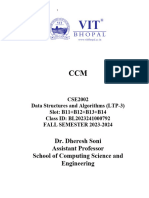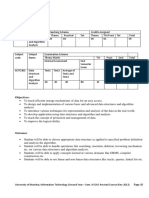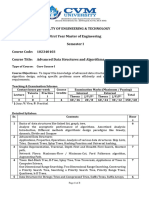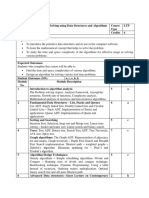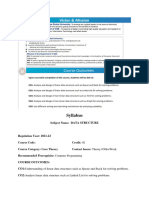Cse2002 Data-structures-And-Algorithms LTP 2.0 2 Cse2002 Data-structures-And-Algorithms LTP 2.0 1 Cse2002-Data Structures and Algorithms
Uploaded by
pankaj yadavCse2002 Data-structures-And-Algorithms LTP 2.0 2 Cse2002 Data-structures-And-Algorithms LTP 2.0 1 Cse2002-Data Structures and Algorithms
Uploaded by
pankaj yadavCourse Code Data Structures and Algorithms CT C
CSE2002 LTP 4
Prerequisite: Introduction to Problem Solving and Programming
Objectives:
1. To understand various types of fundamental data structures (standard and user defined).
2. To learn about algorithm analysis for the run time complexities and the space requirements.
3. To acquire knowledge of data structures and algorithms for implementing various real-world problems.
Expected Outcomes:
Students will be able to
1. Apply the fundamental knowledge of various data structures and algorithms to analyze, design, formulate
and implement algorithm for any real time problem.
2. Apply current techniques in data structures and algorithmic principles for modeling and developing
software systems.
3. Choose an appropriate design paradigm that solves the given problem efficiently along with appropriate
data structures.
4. Map real-world problems to algorithmic solutions.
Student Outcomes (SO): a,b,i,l,m
a. An ability to apply the knowledge of mathematics, science and computing appropriate to the
discipline
b. An ability to analyze a problem, identify and define the computing requirements appropriate to its
solution.
i. Design and conduct experiments as well as analyze and interpret data
l. An ability to apply mathematical foundations, algorithmic principles and computer science theory in the
modelling and design of computer-based systems (CS)
m. An ability to apply design and development principles in the construction of software systems (CS).
Unit No Unit Content No. of SOs
hours
Introduction to Algorithm and Data Structures 6 Hours a,b
Algorithm: Introduction - Algorithm Design – Complexity- Asymptotic
1 notations. Data Structures: Introduction- Classification of Data structure -
Abstract Data Type (ADT).
Sorting and Searching 8 Hours a,b,l
Brute force approach: General method -Sorting (bubble, selection, insertion)
–Searching (Sequential/Linear)
2 Divide and Conquer approach: General method - Sorting ( merge, quick) –
Searching (Binary Search).
List, Statck and Queue ADT 10 Hours a,b,l,m
Linked List: Array Vs Linked List - Singly Linked List, Doubly Linked Lists –
3
Circular Linked Lists-implementation - application.
Stack and Queue: Introduction – implementation (static and dynamic) –
application – Circular queues-application.
TREES AND HASHING 10 Hours a,b,l,m
Linear Vs Non-Linear Data Structures -General Tree – Terminologies -Binary
Tree – Expression Tree - Traversals - Binary Search Tree – AVL Tree – Red
4
block Tree – Splay Tree – B Tree. - Hashing: Introduction – Hash Function-
Methods-Collision Resolution.
Graph ADT 9 Hours a,b,l,m
Graph: Introduction – Representations – Traversals - Topological Sorting –
Connected and Bi-Connected Components – Articulation Point - Shortest-
5 path algorithms (Dijkstra’s and Floyd’s algorithms) - Minimum spanning tree
(Prim’s and Kruskal’s algorithms).
Guest Lecture on Contemporary Topics 2 Hours
Total Lecture: 45 Hours
Mode of Teaching and Learning: Flipped Class Room, One Lecture to be videotaped, Digital/Computer
based models to augment lecture for practice/tutorial, 2 hours lectures by industry experts on
contemporary topics
Mode of Evaluation and assessment:
The assessment and evaluation components may consist of unannounced open book examinations,
quizzes, student’s portfolio generation and assessment, and any other innovative assessment practices
followed by faculty, in addition to the Continuous Assessment Tests and Final Examinations.
Text Books:
1. Thomas H. Cormen , Charles E. Leiserson , Ronald L. Rivest , Clifford Stein,
Introduction to Algorithms, 3rd Edition, MIT Press, 2009
Reference Books:
1. Mark A. Weiss,Data Structures and Algorithm Analysis in C++, 4th Edition, Pearson, 2014
2. Aaron M. Tenenbaum, Yeedidyah Langsam, Moshe J. Augenstein, ‘Data structures using
C’, Pearson Education, 2010.
3. D. E. Knuth, Art of computer programming, Volume 1: Fundamental algorithms,
Addison Wesley, 2011.
Indicative List of Experiments (All the experiments need to be done in C Language)
Description SO
1 Implementation of Sorting Algorithms (Bubble Sort, Merge sort and Quick sort)
2 Implementation of Searching Algorithms (Linear and Binary)
3 Implementation of Single Linked List.
4 Implementation Double Linked List.
5 Implementation Stack using Array and Linked List. a,b,i,l,m
6 Implementation of Queue using Array and Linked List.
7 Implementation of Binary Tree Traversals.
8 Implementation of Binary Search Tree.
9 Implementation of BFS and DFS.
10 Implementation of Dijkstra Shortest Path Algorithms.
11 Implementation of Prims and Kruskal Algorithms.
12 Implementation Hashing Techniques.
Recommendation by the Board of Studies on 27.12.2021
Approval by Academic council on
Compiled by Dr. M. Ashwin & Dr. Sandip Mal
You might also like
- Pvsyst Tutorial v7 Pseudo Sub Hourly enNo ratings yetPvsyst Tutorial v7 Pseudo Sub Hourly en15 pages
- CSD3009 - DATA-STRUCTURES-AND-ANALYSIS-OF-ALGORITHMS - LTP - 1.0 - 29 - CSD3009-DATA-STRUCTURES-AND-ANALYSIS-OF-ALGORITHMS - LTP - 1.0 - 1 - Data Structures and Analysis of AlgorithmsNo ratings yetCSD3009 - DATA-STRUCTURES-AND-ANALYSIS-OF-ALGORITHMS - LTP - 1.0 - 29 - CSD3009-DATA-STRUCTURES-AND-ANALYSIS-OF-ALGORITHMS - LTP - 1.0 - 1 - Data Structures and Analysis of Algorithms3 pages
- Bcse202l Data-Structures-And-Algorithms TH 1.0 70 Bcse202lNo ratings yetBcse202l Data-Structures-And-Algorithms TH 1.0 70 Bcse202l2 pages
- CSE2002 Data - Structures - and - Algorithm - BL2023241000790 - CCM - DR Dheresh SoniNo ratings yetCSE2002 Data - Structures - and - Algorithm - BL2023241000790 - CCM - DR Dheresh Soni57 pages
- CS2202::Data Structures Course Prerequisites: Course ObjectivesNo ratings yetCS2202::Data Structures Course Prerequisites: Course Objectives11 pages
- DS - Data Structure Lesson Plan 2022-23No ratings yetDS - Data Structure Lesson Plan 2022-2329 pages
- L T P C School Total Number of Contact Hours Date of Approval Pre-RequisitesNo ratings yetL T P C School Total Number of Contact Hours Date of Approval Pre-Requisites2 pages
- CSE 5010 - Data Structures and Algorithms AnalysisNo ratings yetCSE 5010 - Data Structures and Algorithms Analysis3 pages
- CSE2003 Data Structures and Algorithms LTPJ CNo ratings yetCSE2003 Data Structures and Algorithms LTPJ C6 pages
- Prof. Abhiram G Ranade Prof. Ajit A Diwan Prof. Sundarviswanathan Madhavanmukund Chennai Mathematical InstituteNo ratings yetProf. Abhiram G Ranade Prof. Ajit A Diwan Prof. Sundarviswanathan Madhavanmukund Chennai Mathematical Institute2 pages
- Mca1002 - Problem Solving Using Data Structures and Algorithms - LTP - 1.0 - 1 - Mca1002No ratings yetMca1002 - Problem Solving Using Data Structures and Algorithms - LTP - 1.0 - 1 - Mca10024 pages
- B.TECH (Computer Engineering) Semester - Iii Course SyllabusNo ratings yetB.TECH (Computer Engineering) Semester - Iii Course Syllabus17 pages
- Course Outline (Data Structures and Algorithms) 2021No ratings yetCourse Outline (Data Structures and Algorithms) 20217 pages
- Data Structures: Course Code: 13CT1106 L TPC 4 0 0 3No ratings yetData Structures: Course Code: 13CT1106 L TPC 4 0 0 33 pages
- Syllabus for First Year B.tech (2023-24), MBA, MBA (Integrated) and MCA Programmes (2024-25)No ratings yetSyllabus for First Year B.tech (2023-24), MBA, MBA (Integrated) and MCA Programmes (2024-25)2 pages
- CS3353 - C Programming and Data Structures SyllabusNo ratings yetCS3353 - C Programming and Data Structures Syllabus2 pages
- Course Code Category Hours / Week Credits Maximum Marks L T P C CIA SEE TotalNo ratings yetCourse Code Category Hours / Week Credits Maximum Marks L T P C CIA SEE Total2 pages
- SWE2001 - DATA-STRUCTURES-AND - ITS-APPLICATIONS - ETH - 1.3 - 15 - SWE2001 - Data Structures and Its Applications - 1.3No ratings yetSWE2001 - DATA-STRUCTURES-AND - ITS-APPLICATIONS - ETH - 1.3 - 15 - SWE2001 - Data Structures and Its Applications - 1.34 pages
- Ita3002 Data-Structures Eth 1.0 37 Ita3002No ratings yetIta3002 Data-Structures Eth 1.0 37 Ita30022 pages
- Gujarat Technological University Computer Engineering (07) / Information Technology (16) / Information & Communication TechnologyNo ratings yetGujarat Technological University Computer Engineering (07) / Information Technology (16) / Information & Communication Technology3 pages
- MCSE501L_DATA-STRUCTURES-AND-ALGORITHMS_TH_1.0_0_MCSE501L (2)No ratings yetMCSE501L_DATA-STRUCTURES-AND-ALGORITHMS_TH_1.0_0_MCSE501L (2)2 pages
- CS 253 Data and File Structures: Course OutlineNo ratings yetCS 253 Data and File Structures: Course Outline3 pages
- Master of Science-Computer Science-SyllabusNo ratings yetMaster of Science-Computer Science-Syllabus22 pages
- Lecture 5 - CS50's Web Programming With Python and JavaScriptNo ratings yetLecture 5 - CS50's Web Programming With Python and JavaScript24 pages
- Toon Boom Storyboard Pro 22 Windows ShortcutsNo ratings yetToon Boom Storyboard Pro 22 Windows Shortcuts2 pages
- Instructions for Matsutec AIS HA-102 ConfigNo ratings yetInstructions for Matsutec AIS HA-102 Config9 pages
- Lesson 3 - Compare and Contrast Various 21ST Century Genres From Earlier Genres-Period88% (8)Lesson 3 - Compare and Contrast Various 21ST Century Genres From Earlier Genres-Period20 pages
- Kami Export - Alvaro Andre Robles Tipte - WB Unit 9No ratings yetKami Export - Alvaro Andre Robles Tipte - WB Unit 98 pages
- SIMEK Tangible Religion - Amulets, Illnesses, and The Demonic Seven SistersNo ratings yetSIMEK Tangible Religion - Amulets, Illnesses, and The Demonic Seven Sisters22 pages





